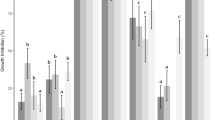Abstract
The antifungal activities of the essential oil fromAgastache rugosa and its main component, estragole, combined with ketoconazole, one of the azole antibiotics commonly used to treat infections caused byTrichophyton species, were evaluated in this study. The combined effects were measured by the checkerboard microtiter and the disk diffusion tests, againstT. erinacei, T. mentagrophytes, T. rubrum, T. schoenleinii andT. soudanense. Susceptibility of the fiveTrichophyton species to the oil alone, or ketoconazole alone, differed distinctly. The fractional inhibitory concentration indices (FICI) of ketoconazole combined with estragole orA. rugosa essential oil, against the testedTrichophyton species, were between 0.05 and 0.27, indicating synergistic effects. These drug combinations exhibited the most significant synergism againstT. mentagrophytes, with FICIs of 0.05 and 0.09 for estragole and the essential oil fraction fromA. rugosa, respectively. Isobolograms based on the data from checkerboard titer tests also indicated significant synergism between ketoconazole and theAgastache oil fraction or estragole, against theTrichophyton species evaluated.Trichophyton susceptibility to ketoconazole was significantly improved by combination with theAgastache rugosa oil fraction or its main component, estragole.
Similar content being viewed by others
References
Bidlack, W. R., Omaye, S. T., Meskin, M. S., and Topham, D., Phytochemicals as bioactive agents. Technomic Publishing Company, Lancaster, pp. 106–110 (2000).
Davidson, P. M. and Parish, M. E., Methods for testing the efficacy of food antimicrobials.Food Technol., 43, 148–155 (1989).
Faleiro, M. L., Miguel, M. G., Ladeiro, F., Venancio, F., Tavares, R., Brito, J. C., Rigueiredo, A. C., Barroso, J. G., and Pedro, L. G., Antimicrobial activity of essential oils isolated from Portuguese endemic species ofThymus.Lett. Appl. Microb., 36, 35–40 (2003).
Giordani, R., Trebaux, J., Masi, M., and Regli, P., Enhanced antifungal activity of ketoconazole byEuphorbia characias latex againstTrichophyton albicans.J. Ethnopharmacol., 78, 1–5 (2001).
Hammer, K., Carson, C. F., and Riley, T. V.,In-vitro activity of essential oils, in particularMelaleuca alternifolia (tea tree) oil and tea tree oilproducts,againstTrichophyton spp.J. Antimicrob. Chemother., 42, 591–595 (1998).
Inouye, S., Uchida, K., and Yamaguchi, H.,In vitro andin vivo anti-Trichophytonactivity of essential oils by vapor contact.Mycoses, 44, 99–107 (2001).
Nidiry, E. S., Structure-fungitoxicity relationships of the monoterpenoids of the essential oils of Peppermint (Mentha piperita) and scented geranium (Pelargonium graveolens).J. Essent. Oil Res., 10, 628–632 (1998).
Patra, M., Shahi, S. K., Midgely, G., and Dikshit, A., Utilization of essential oil as natural antifungal against nail-infective fungi.Flavour Frag. J., 17, 91–94 (2002).
Shahi, S. K., Shukla, A. C., Bajaj, A. K., Medgely, G., and Dikshit, A., Broad spectrum antimycotic drug for the control of fungal infection in human beings.Curr. Sci., 76, 836–839 (1999).
Shin, S. and Kang, C. A., Antifungal activity of the essential oil ofAgastacherugosa Kuntze and its synergismwith ketoconazole.Lett. Appl. Microbiol., 36, 111–115 (2003).
Shin, S.,Anti-Aspergillus activities of plant essential oils and their combination effects with ketoconazole or amphotericin B.Arch. Pharm, Res., 26, 389–393 (2003).
Sugar, A. M., Alsip, S. G., Galgiani, J. N., Graybill, J. R., Dismukes, W. E., Claud, G. A., Craven, P. C., and Stevens, D. A., Pharmacology and toxicity of high-dose ketoconazole.Antimicrob. Agents Chemother., 31, 1874–1878 (1987).
White, R. L., Burgess, D. S., Manduru, M., and Bosso, J. A., Comparison of three different in vitro methods of detecting synergy: timekill, checkerboard, and E test.Antimicrob. Agents Chemother., 40, 1914–1918 (1996).
Yoon, S. Y., Eo, S. K., Lee, D. K., and Han S. S., Antimicrobial activity of Ganodermalucidum extract alone and in combination with some antibiotics.Arch. Pharm. Res., 6, 438–442 (1994).
Author information
Authors and Affiliations
Corresponding author
Rights and permissions
About this article
Cite this article
Shin, S. Essential oil compounds fromAgastache rugosa as antifungal agents againstTrichophyton species. Arch Pharm Res 27, 295–299 (2004). https://doi.org/10.1007/BF02980063
Received:
Issue Date:
DOI: https://doi.org/10.1007/BF02980063



